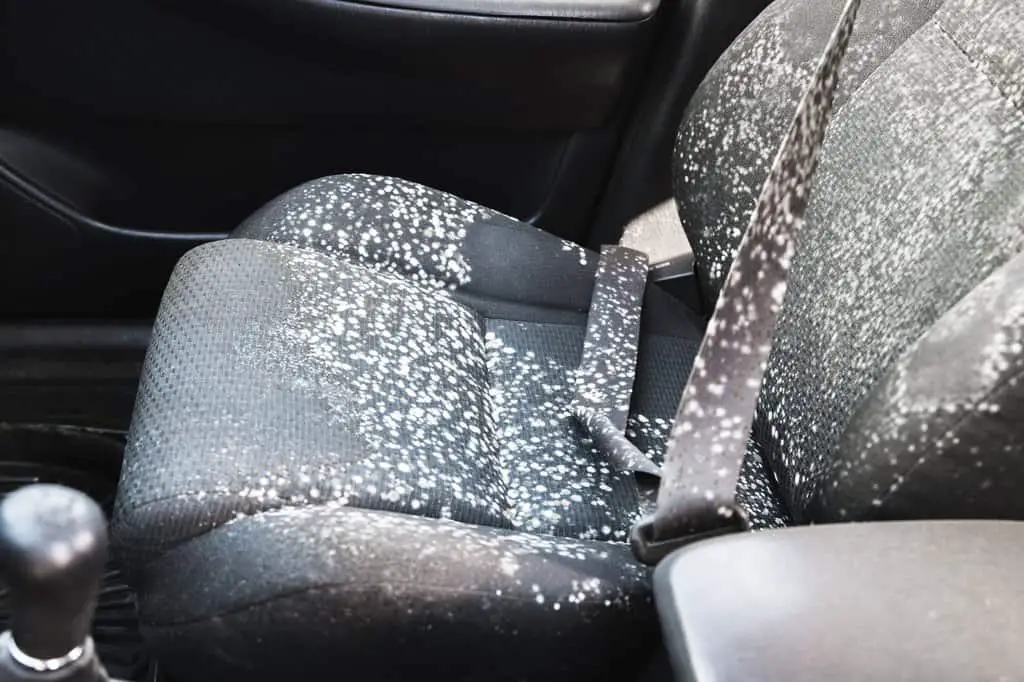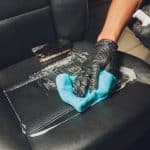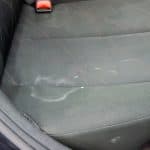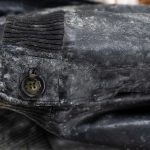Mold and mildew are among the top problems many people face regarding leather items, including leather car seats. Even if you have dark-colored car seats and the mold is not visible, you’ll still be able to smell it and who wants to have fungi growing in their car’s interior? In this article, we’ll be talking about mold in leather car seats and how to remove them effectively.
Things you should know about mold in cars
Before we get to the method of removing mold in leather car seats, there are a few things you should know about mold in cars. Not only do molds ruin the aesthetics of your car’s interior, but they also pose a health risk because of the spores that can cause respiratory and allergic reactions.
Mold vs mildew
Their difference is that mold will look fuzzy or slimy and can be black or deep green in color, sometimes in more vibrant colors. Meanwhile, mildew has a powdery and grayish look and will appear flat on the surface in contrast to mold which has a raised texture.

You probably hear these two together a lot and it’s because if you see mildew then there’s definitely mold growing somewhere too. Basically, all you need to remember is that mildew refers to mold growth or fungus. Molds are more common on organic materials like leather, but also on walls, and ceilings. Mildew often forms in unaired places such as shower walls, basements, and car interiors when it’s humid.
How do car seats get moldy?
Since we established that molds are caused by mildew, all it takes is a porous surface and a lot of moisture on leather car seats. When it’s dark, warm, and humid or moist inside your car, it becomes the perfect place for molds to thrive in.
Leather surfaces are more susceptible to mildew especially materials with thin leather fibers because they are easily eaten away by fungus. Even if you don’t get the leather car seats wet, your sweat can still cause the buildup of moisture and heat. This is enough to cause mold growth which can be hard to get rid of and will quickly spread around the interior of your car.
Where else can mold grow in cars?
Molds can grow on almost any surface, especially upholstered furniture. When you have mold already growing inside your car, it can spread from the leather car seats to the dashboard, the car’s carpet flooring, and even the steering wheel. Basically, it will infect every surface in your car’s interior.
Can mold in your car make you sick?
Yes. This is the number one concern for mold and fungus-infested areas. You don’t even have to come into physical contact with the mold, as long as you’re inside a closed space with moldy surfaces, the pores released from the fungus will still make you sick.
Examples of health risks you can get from being exposed to mold are skin irritations, lung infections, asthma, nasal congestion, and coughing. It will also infect your eyes and throat. When there is too much car mold, your car’s air conditioning system may also be affected which can cause what they call the “toxic car syndrome”.
How long does mold stay in your car?
All it takes is about 12 hours given the right conditions for mold to grow in the interior of your car. Once they’re there, the mold growth can last around 3 months and they will most likely have infested every surface inside your car.
The longer you leave them alone and uncleaned, the more stubborn they will be to remove and the more damage they will cause to both your health and your car’s interior.
What can mold do to your car seats?
Mold can do a lot of damage to your leather car seats and here are some of them:
Discoloration
Mold can change the color of the surface it grows on, especially on leather seats. They are very visible on light-colored surfaces, but they can also be obvious on dark-colored leather because of the spores that have various vibrant colors. You’ll definitely notice if there’s mold growth on your car seats because a certain area will have a different color and will show dirty patches.
Weak leather fibers
We mentioned above that the mold/fungus will eat away the fibers of your car seat. Once it starts eating away at the leather fibers, the material will become more brittle and will eventually start tearing. Even if you remove the mold at the surface level, if you don’t deep clean your car and do it thoroughly, it will still grow back pretty quickly.
Bad smells
Another obvious sign you have mold growth somewhere inside your car is when you notice an earth-like and musty smell. The smell of mold can be difficult to get rid of and can cause dizziness. Of course, when there is a bad smell caused by fungi, the air quality inside your car will also be bad exposing you and your passengers to respiratory complications.
How to remove mold from your car seats
Now that we’ve discussed the risks and damage mold can cause to your leather car seats, it’s time to get into the details of how to effectively remove them. Here are some methods that you can choose from:
Toothpaste
Toothpaste is an easy go-to product as it’s readily available and already comes practically ready to use. Toothpaste is also great as it doesn’t leave behind any sour smells and can even smoothen the surface.
Things you will need:
- White toothpaste (not the gel type)
- Soft-bristled brush or toothbrush
- Microfiber cloth or clean cloth
- Face mask or gas mask
- Gloves
- Water
- Leather conditioner
Steps:
- Always wear a mask and gloves to protect yourself from mold spores.
- Wipe away the majority of the mold that you can easily remove with a damp cloth.
- Dab little dots of toothpaste around the affected area.
- Damp the toothpaste in a little bit of water.
- Softly scrub the stubborn mold away in a circular motion.
- Wipe the toothpaste off with another clean cloth.
- You may want to condition your seats as the toothpaste is an abrasive.
Alcohol spray solution
Alcohol is always a great cleaning solution for removing mold and fungi growth on any type of surface including leather car seats. If you don’t want to use rubbing alcohol, you can use the lemon or white vinegar mixtures because they will work similarly and just as well as the alcohol solution.
Things you will need:
- Rubbing alcohol, white vinegar or lemon juice
- Distilled water
- Sponge or microfiber cloth
- Spray bottle or plastic container
- Face masks and gloves
- Soft-bristled brush
Steps:
- Wear your protective gear and park your car in a well-ventilated area.
- Using a soft-bristled brush, remove as much mold as you can while making sure you don’t brush too harshly.
- Include the cracks and wrinkles of your car’s interior.
- Mix equal parts of distilled water and alcohol in a spray bottle. You can use the alternatives here with the same 1:1 ratio.
- Spray the cleaning solution onto the microfiber cloth and once it’s damp, you can start by testing it out on a small hidden area to see any reactions from the leather materials.
- Once you’ve made sure that the cleaning solution does not react badly to the leather seats, you can start the wiping process using circular motions.
- Avoid rubbing too hard or getting it too wet because it will cause damage to the leather surface.
- After removing all the mold and mildew, use another clean microfiber and distilled water to wipe down the entire surface.
- Allow the surfaces to air dry and apply leather conditioner once you’re done.
Baby shampoo
You can use baby shampoo to remove mold in your car’s interior. This is a good alternative to the other cleaning solutions since it is non-toxic and gentle enough to be used on leather car seats to remove mold and unwanted smells without damaging the leather surface.
Things you will need:
- Baby shampoo
- Microfiber cloth
- Distilled water
- Protective gear
- Face mask
- Spray bottle
Steps:
- Wear your protective gear and as always, move your care into an open area with proper ventilation.
- Using a microfiber cloth, wipe away the mold spores on the surfaces.
- Mix a bottle of baby shampoo and distilled water into a spray bottle. Use a 1:1 ratio.
- Spray the baby shampoo solution onto the microfiber cloth and use the damp cloth to wipe the entire surface of your car seats and other affected areas.
- Work in circular motions and make sure to include the crevices as mold can be abundant there.
- Once you’ve thoroughly cleaned all the surfaces, use another microfiber cloth and dampen it with distilled water. Wipe the entire surface.
- Allow the seats to air dry and apply conditioner after.
Baking soda
This is the most ideal method when it comes to deep mold removal. We mentioned in our other articles how baking soda can effectively remove unwanted smells and stains on your leather item. But did you know that if you mix baking soda with white vinegar and liquid dish soap, it can kill off mold spores and get rid of that musty mold smell? Here’s how:
Things you will need:
- Baking soda
- Dish soap
- White vinegar
- Distilled water
- Face masks and gloves
- Microfiber cloth
- Plastic container
- Nylon brush
Steps:
- Wear your protective gear and brush off the mold spores using a clean nylon brush.
- Mix the baking soda, dish soap, and white vinegar into a plastic container until it forms a paste-like texture.
- Apply the cleaning paste onto the affected area with molds and leave it there for about 10 minutes.
- Wipe off the excess with a damp cloth using a soft cloth and distilled water.
- Repeat the process until all the mold spores are gone.
- Use another damp clean cloth to wipe off the paste residue on the surfaces.
- Use a dry cloth to remove the excess moisture on the leather surface, let it air dry, and apply leather conditioner after.
Leather cleaning products
Leather cleaners are the safest way to clean your leather upholstery. They also help nourish your leather and keep it healthy. You may want to use different cleaners for faux leather and real leather, but most real leather products are also great for faux leather.
Leather Honey works great for real leather and faux leather and is ready to use. All you need is a clean cloth to wipe it with and simply rub the mold away. You may want to concentrate on stubborn areas, but it will easily take most of it away while protecting the leather.
- Non-toxic, Gentle Cleaner: Our proven, rejuvenating formula is a powerful, fragrance-free cleaner...
- Clean All Types of Leather: Quickly and gently removes dirt, oil, tough stains and grime from car...
- Safe for You, Safe for Leather: Made with non-toxic, high-quality ingredients that makes your...
Professional cleaning services
When it comes to your car, there are many professional detailing services out there that specialize in restoring your car to sparkling condition. They usually have many tools and techniques specifically for safe and effective cleaning. They may even do UV treatment which will kill any remaining bacteria that you aren’t able to see, preventing future mold.
How to prevent mold from growing in your car
Once you’ve gotten rid of the mold growth in your car’s interior and the car seats, the next important thing you should do is make sure you won’t face the same problem again. Here are some ways to prevent mold from growing in your car again:
Fix the root problem
Mold and mildew only thrive because of certain conditions that allow them to survive and grow inside your car. Fix the root problems first such as leaks, too much moisture and heat, and bad car ventilation. This will ensure that you’re not only going for band-aid solutions and actually aiming for an environment where mold can’t possibly grow.
Be more mindful when it comes to liquids
As soon as liquids, even your sweat touches the surface of your leather car seats, wipe them off immediately. Do not wait for the liquid to get absorbed in the carpet or the leather pores. You can also effectively dry out damp areas using natural sunlight or a hairdryer. Just be careful as too much heat and sunlight can also warp and dry out the leather material.
Add a car dehumidifier
Dehumidifiers are your best friend when it comes to getting rid of humidity inside closed spaces including your car. If your car is not humid, you’re preventing mildew to form that causes mold in the first place.
You can also place a box of baking soda on the car floor or in the corners. Baking soda is very absorbent and will remove excess moisture in the air and unpleasant smells in general. Uncooked rice is also a great alternative to baking soda.
Make sure there is proper ventilation
This is perhaps the most important factor in preventing mold growth in your car. Making sure that your car has proper ventilation will require you to let the sunshine and air in. This will help in letting out the stale air inside your car and allow fresh air inside. Park your car in an open area with enough sunlight for about 15 minutes and not longer as too much sunlight can damage the interiors.
Conclusion
Mold and mildew pose health risks and will ruin the interiors of your car. That’s why if you spot a small area with mildew or mold growth, you shouldn’t wait another day before cleaning it out as it only takes half a day for it to cultivate and spread. We hope that this article provided you with enough knowledge and methods when it comes to removing mold in leather car seats.
FAQ
Can I leave a vinegar solution on the mold overnight?
We don’t recommend doing this as the acids in the vinegar solution will most likely dry out and damage the leather fibers overnight. Even if you mix vinegar with equal parts of water to dilute it, we recommend leaving it on for up to 10 minutes only. After that, immediately wipe off the vinegar solution with a damp cloth using only water to remove the acid residue on the leather surface.
Is mold on leather permanent?
Mold can be quite difficult to remove, especially if left for a very long time. They can embed themselves deep into the leather and cause visible stains. They can also cause the leather to weaken due to rot. However, you may be able to save it through professional cleaning services if it’s a severe issue. If the mold is still new, you will be able to remove it easily.







